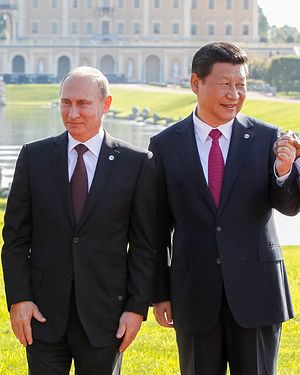After 10 years of negotiations, China and Russia inked a massive natural gas deal during the second day of Russian President Vladimir Putin’s visit to China this week.
Russian state media reports on the parameters of the deal were largely consistent with prior expectations. For example, Russia Today reported that, under the deal, “Russia will supply China [with] 38 billion cubic meters of gas per year via the eastern ‘Power of Siberia’ pipeline, which crosses Siberia and reaches China’s populous northeast regions.”
It also cited Gazprom CEO Aleksey Miller as saying that the total value of the 30-year deal was $400 billion. However, according to the report, Miller refused to disclose the exact price China will pay for the natural gas, which he said was a “commercial secret.”
RT notes that if all of the $400 billion is earmarked for China’s purchase of the gas, Beijing will be paying about $350 per thousand cubic meters of gas. According to Bloomberg News, China currently pays the same rate for natural gas from Turkmenistan, which is about two-thirds of what it costs China to import liquefied natural gas (LNG). It is also significantly less than the $380.50 per thousand cubic meters that Gazprom sold natural gas to Western Europe for last year.
Moreover, it’s unlikely that the entire $400 billion will go toward China’s purchase of the actual natural gas. As noted above, Russia is constructing the so-called “Power of Siberia” pipeline to transport the natural gas to China.
The nearly 4,000 km pipeline—which is also expected to transport LNG to Russia’s far eastern port of Vladivostok for export to other Asian nations—is prohibitively expensive. The Financial Times reported last year that the cost of the pipeline was expected to be around $46 billion without the spur pipeline to China. The Bloomberg News article cited above suggests that the spur pipeline to China alone may cost around $22 billion. Some of the $400 billion contract is likely designated to helping Russia finance the costs of this construction.
The Russian media reports did not specify exactly when Russia will begin supplying the natural gas to China. However, the Financial Times, citing China’s state-owned China National Petroleum Corp, reports that Russian gas will begin flowing to China in 2018. This is consistent with reports before the deal was inked.
The price China would pay for the natural gas was seen as the primary sticking point in the decade-long negotiations. Russia had demanded China pay more for the gas than Beijing would agree to. China’s leverage on the issue was widely seen as having grown in recent months, however. This was partly because Beijing has a reduced need for Russian gas as a result of rising imports from Central Asia and Myanmar. At the same time, Gazprom has become more desperate to ink a deal with China as the Ukraine crisis threatens to imperil its economic ties with Western Europe.
Russian Prime Minister Dmitry Medvedev had tried to play down concerns in Russia that Moscow would cave to China on the price issue. “One side always wants to sell for a higher price, while the other wants to buy for a lower price,” Medvedev said ahead of Putin’s trip to Shanghai this week. He added, “I believe that in the long run, the price will be fair and totally comparable to the price of European supplies.”
Without knowing the exact details of the agreement, it appears the concerns about Russian caving to China on price were justified. Even if the entire $400 billion goes only to paying for the natural gas, Gazprom will still be selling China natural gas at a lower price than it currently charges Europe. Typically, Asia pays a higher price for natural gas than Europe does, although this discrepancy has much to do with the amount of LNG each region imports.
At the same time, natural gas prices could very well fall significantly in the years and decades ahead as a result of new supplies from the Western Hemisphere and reduced demand from emerging markets. Moreover, the exact terms of the agreement are important in assessing the deal because Russia was seeking a sizable advanced payment, likely to help finance the pipeline. A large, up-front lump sum would make the deal more advantageous to Russia, particularly given its current economic woes.
































